NCERT Solutions for Class 9 Maths Chapter 1 Number Systems is prepared by our best subject experts teachers group thats help students to understand all the topics easily. These Solutions of NCERT Maths help the students in solving the problems efficiently for the upcoming exams. With the help of these NCERT Solutions for Class 9 Maths, students can understand the complex topics of class 9 Maths. They also focus on formulating the solutions of Maths in such a way that it is easy for the students to understand.
ALSO CHECK – NCERT Solutions for Class 10 Maths
ALSO CHECK – Download the free Class 10th Notes here
These NCERT Solutions for Class 9 Maths Chapter 1 helps students to understand rest of the chapter as well as upcoming Class 10 Maths problems. Based on these NCERT Solutions, students can practise and prepare for their upcoming any board exams that is based on NCERT Syllabus. So all you need to do stay focus and practising more an more questions.
NCERT Solutions for Class 9 Maths Chapter 1 Number Systems
Exercise 1.1 Page: 5
Question 1.
Is zero a rational number? Can you write it in the form 𝑝𝑞,where p and q are integers and q ≠0?
Solution:
We know that, a number is said to be rational if it can be written in the form p/q , where p and q are integers and q ≠ 0.
Taking the case of ‘0’,
Zero can be written in the form 0/1, 0/2, 0/3 … as well as , 0/1, 0/2, 0/3 ..
Since it satisfies the necessary condition, we can conclude that 0 can be written in the p/q form, where q can either be positive or negative number.
Hence, 0 is a rational number.
Question 2.
Find six rational numbers between 3 and 4.
Solution:
Let qi be the rational number between 3
and 4, where j = 1 to 6.
∴ Six rational numbers are as follows: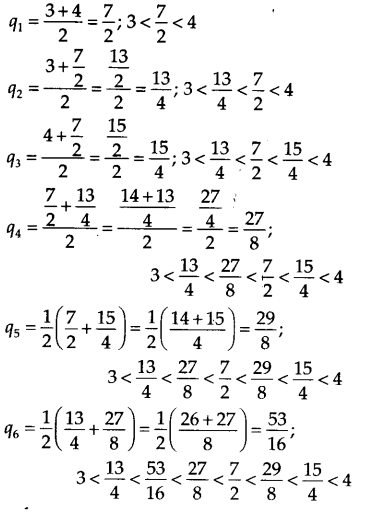
Thus, the six rational numbers between 3 and 4 are
Question 3.
Find five rational numbers between 35 and 45.
Solution:
Since, we need to find five rational numbers, therefore, multiply numerator and denominator by 6.
Question 4.
State whether the following statements are true or false. Give reasons for your answers.
(i) Every natural number is a whole number.
(ii) Every integer is a whole number.
(iii) Every rational number is a whole number.
Solution:
(i) True
∵ The collection of all natural numbers and 0 is called whole numbers.
(ii) False
∵ Negative integers are not whole numbers.
(iii) False
∵ Rational numbers are of the form p/q, q ≠ 0 and q does not divide p completely that are not whole numbers.
Exercise 1.2 Page: 8
Question 1.
State whether the following statements are true or false. Justify your answers.
(i) Every irrational number is a real number.
(ii) Every point on the number line is of the form √m , where m is a natural number.
(iii) Every real number is an irrational number.
Solution:
(i) True
Because all rational numbers and all irrational numbers form the group (collection) of real numbers.
(ii) False
Because negative numbers cannot be the square root of any natural number.
(iii) False
Because rational numbers are also a part of real numbers.
Question 2.
Are the square roots of all positive integers irrational? If not, give an example of the square root of a number that is a rational number.
Solution:
No, the square roots of all positive integers are not irrational.
For example,
√4 = 2 is rational.
√9 = 3 is rational.
Hence, the square roots of positive integers 4 and 9 are not irrational. ( 2 and 3, respectively).
Question 3.
Show how √5 can be represented on the number line.
Solution:
Draw a number line and take point O and A on it such that OA = 1 unit. Draw BA ⊥ OA as BA = 1 unit. Join OB = √2 units.
Now draw BB1 ⊥ OB such that BB1 =1 unit. Join OB1 = √3 units.
Next, draw B1B2⊥ OB1such that B1B2 = 1 unit.
Join OB2 = units.
Again draw B2B3 ⊥OB2 such that B2B3 = 1 unit.
Join OB3 = √5 units.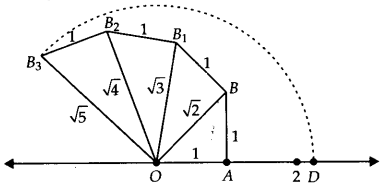
Take O as centre and OB3 as radius, draw an arc which cuts the number line at D.
Point D
represents √5 on the number line.
Question 4.
Take a large sheet of paper and construct the ‘square root spiral’ in the following fashion. Start with a point O and draw a line segment OP1 of unit length. Draw a line segment P1P2 perpendicular to OP1 of unit length (see Fig. 1.9). Now draw a line segment P2P3perpendicular to OP2. Then draw a line segment P3P4 perpendicular to OP3. Continuing in Fig. 1.9 :

Constructing this manner, you can get the line segment Pn-1Pn by square root spiral drawing a line segment of unit length perpendicular to OPn-1. In this manner, you will have created the points P2, P3,….,Pn,… ., and joined them to create a beautiful spiral depicting √2, √3, √4, …
Solution:

Step 1: Mark a point O on the paper. Here, O will be the center of the square root spiral.
Step 2: From O, draw a straight line, OA, of 1cm horizontally.
Step 3: From A, draw a perpendicular line, AB, of 1 cm.
Step 4: Join OB. Here, OB will be of √2
Step 5: Now, from B, draw a perpendicular line of 1 cm and mark the end point C.
Step 6: Join OC. Here, OC will be of √3
Step 7: Repeat the steps to draw √4, √5, √6….
Exercise 1.3 Page: 14
Question 1.
Write the following in decimal form and say what kind of decimal expansion each has![]()
(i) 36/100
Solution:

= 0.36 (Terminating)
(ii)1/11
Solution:



Solution:


= 4.125 (Terminating)
(iv) 3/13
Solution:


(v) 2/11
Solution:

(vi) 329/400
Solution:

= 0.8225 (Terminating)
Question 2.
You know that 1/7 = 0.142857. Can you predict what the decimal expansions of 2/7, 3/7, 4/7, 5/7, 6/7 are, without actually doing the long division? If so, how?
Solution:

Thus, without actually doing the long division we can predict the decimal expansions of the given rational numbers.
Question 3.
Express the following in the form 𝑝𝑞 where p and q are integers and q ≠ 0.
(i) 0.6¯
(ii) 0.47¯
(iii) 0.001⎯⎯⎯⎯⎯⎯⎯⎯⎯
Solution:
(i) Let x = 0.6¯ = 0.6666… … (1)
As there is only one repeating digit,
multiplying (1) by 10 on both sides, we get
10x = 6.6666… … (2)
Subtracting (1) from (2), we get
10x – x = 6.6666… -0.6666…
⇒ 9x = 6 ⇒ x = 6/9 = 2/3
Thus, 0.6¯ = 2/3
(ii) Let x = 0.47¯ = 0.4777… … (1)
As there is only one repeating digit, multiplying (1) by lo on both sides, we get
10x = 4.777
Subtracting (1) from (2), we get
10x – x = 4.777…… – 0.4777…….
⇒ 9x = 4.3 ⇒ x = 43/90
Thus, 0.47¯ = 43/90

Solution:

Assume that x = 0.001001…
Then, 1000x = 1.001001…
1000x = 1 + x
999x = 1
x = 1/999
Question 4.
Express 0.99999…. in the form p/q . Are you surprised by your answer? With your teacher and classmates discuss why the answer makes sense.
Solution:
Let x = 0.99999….. …. (i)
As there is only one repeating digit,
multiplying (i) by 10 on both sides, we get
10x = 9.9999 … (ii)
Subtracting (i) from (ii), we get
10x – x = (99999 ) — (0.9999 )
⇒ 9x = 9 ⇒ x = 99 = 1
Thus, 0.9999 =1
As 0.9999… goes on forever, there is no such a big difference between 1 and 0.9999
Hence, both are equal.
Question 5.
What can the maximum number of digits be in the repeating block of digits in the decimal expansion of 1/17? Perform the division to check your answer.
Solution:
In 1/17, In the divisor is 17.
Since, the number of entries in the repeating block of digits is less than the divisor, then the maximum number of digits in the repeating block is 16.
Dividing 1 by 17, we have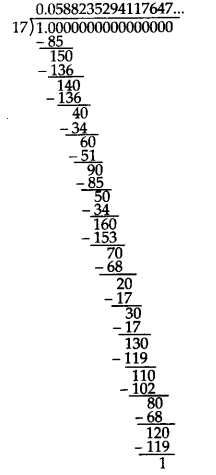
The remainder I is the same digit from which we started the division.

Thus, there are 16 digits in the repeating block in the decimal expansion of 1/17.
Hence, our answer is verified.
Question 6.
Look at several examples of rational numbers in the form 𝑝/𝑞 (q ≠ 0). Where, p and q are integers with no common factors other that 1 and having terminating decimal representations (expansions). Can you guess what property q must satisfy?
Solution:
Let us look decimal expansion of the following terminating rational numbers: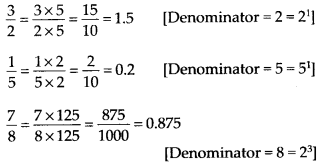
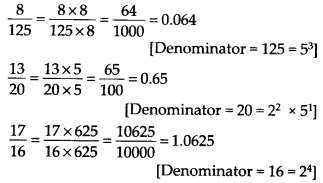
We observe that the prime factorisation of q (i.e. denominator) has only powers of 2 or powers of 5 or powers of both.
Question 7.
Write three numbers whose decimal expansions are non-terminating non-recurring.
Solution:
√2 = 1.414213562 ………..
√3 = 1.732050808 …….
√5 = 2.23606797 …….
Question 8.
Find three different irrational numbers between the rational numbers 57 and 911 .
Solution:
We have,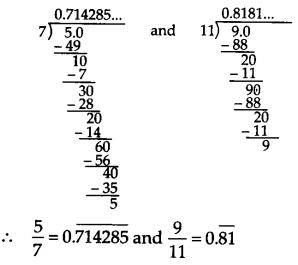
Three different irrational numbers are:
- 0.73073007300073000073…
- 0.75075007300075000075…
- 0.76076007600076000076…
Question 9.
Classify the following numbers as rational or irrational
(i)√23
Solution:
√23 = 4.79583152331…
Since the number is non-terminating non-recurring therefore, it is an irrational number.
(ii)√225
Solution:
√225 = 15 = 15/1
Since the number can be represented in p/q form, it is a rational number.
(iii) 0.3796
Solution:
Since the number,0.3796, is terminating, it is a rational number.
(iv) 7.478478
Solution:
The number,7.478478, is non-terminating but recurring, it is a rational number.
(v) 1.101001000100001…
Solution:
Since the number,1.101001000100001…, is non-terminating non-repeating (non-recurring), it is an irrational number.
Exercise 1.4 Page: 18
Question 1 – Visualise 3.765 on the number line, using successive magnification.
Solution:



Exercise 1.5 Page: 24
1. Classify the following numbers as rational or irrational:
(i) 2 –√5
Solution:
We know that, √5 = 2.2360679…
Here, 2.2360679…is non-terminating and non-recurring.
Now, substituting the value of √5 in 2 –√5, we get,
2-√5 = 2-2.2360679… = -0.2360679
Since the number, – 0.2360679…, is non-terminating non-recurring, 2 –√5 is an irrational number.
(ii) (3 +√23)- √23
Solution:
(3 +√23) –√23 = 3+√23–√23
= 3
= 3/1
Since the number 3/1 is in p/q form, (3 +√23)- √23 is rational.
(iii) 2√7/7√7
Solution:
2√7/7√7 = ( 2/7)× (√7/√7)
We know that (√7/√7) = 1
Hence, ( 2/7)× (√7/√7) = (2/7)×1 = 2/7
Since the number, 2/7 is in p/q form, 2√7/7√7 is rational.
(iv) 1/√2
Solution:
Multiplying and dividing numerator and denominator by √2 we get,
(1/√2) ×(√2/√2)= √2/2 ( since √2×√2 = 2)
We know that, √2 = 1.4142…
Then, √2/2 = 1.4142/2 = 0.7071..
Since the number , 0.7071..is non-terminating non-recurring, 1/√2 is an irrational number.
(v) 2
Solution:
We know that, the value of = 3.1415
Hence, 2 = 2×3.1415.. = 6.2830…
Since the number, 6.2830…, is non-terminating non-recurring, 2 is an irrational number.
2. Simplify each of the following expressions:
(i) (3+√3)(2+√2)
Solution:
(3+√3)(2+√2 )
Opening the brackets, we get, (3×2)+(3×√2)+(√3×2)+(√3×√2)
= 6+3√2+2√3+√6
(ii) (3+√3)(3-√3 )
Solution:
(3+√3)(3-√3 ) = 32-(√3)2 = 9-3
= 6
(iii) (√5+√2)2
Solution:
(√5+√2)2 = √52+(2×√5×√2)+ √22
= 5+2×√10+2 = 7+2√10
(iv) (√5-√2)(√5+√2)
Solution:
(√5-√2)(√5+√2) = (√52-√22) = 5-2 = 3
3. Recall, π is defined as the ratio of the circumference (say c) of a circle to its diameter, (say d). That is, π =c/d. This seems to contradict the fact that π is irrational. How will you resolve this contradiction?
Solution:
There is no contradiction. When we measure a value with a scale, we only obtain an approximate value. We never obtain an exact value. Therefore, we may not realize whether c or d is irrational. The value of π is almost equal to 22/7 or 3.142857…
4. Represent (√9.3) on the number line.
Solution:
Step 1: Draw a 9.3 units long line segment, AB. Extend AB to C such that BC=1 unit.
Step 2: Now, AC = 10.3 units. Let the centre of AC be O.
Step 3: Draw a semi-circle of radius OC with centre O.
Step 4: Draw a BD perpendicular to AC at point B intersecting the semicircle at D. Join OD.
Step 5: OBD, obtained, is a right angled triangle.
Here, OD 10.3/2 (radius of semi-circle), OC = 10.3/2 , BC = 1
OB = OC – BC
⟹ (10.3/2)-1 = 8.3/2
Using Pythagoras theorem,
We get,
OD2=BD2+OB2
⟹ (10.3/2)2 = BD2+(8.3/2)2
⟹ BD2 = (10.3/2)2-(8.3/2)2
⟹ (BD)2 = (10.3/2)-(8.3/2)(10.3/2)+(8.3/2)
⟹ BD2 = 9.3
⟹ BD = √9.3
Thus, the length of BD is √9.3.
Step 6: Taking BD as radius and B as centre draw an arc which touches the line segment. The point where it touches the line segment is at a distance of √9.3 from O as shown in the figure.

5. Rationalize the denominators of the following:
(i) 1/√7
Solution:
Multiply and divide 1/√7 by √7
(1×√7)/(√7×√7) = √7/7
(ii) 1/(√7-√6)
Solution:
Multiply and divide 1/(√7-√6) by (√7+√6)[1/(√7-√6)]×(√7+√6)/(√7+√6) = (√7+√6)/(√7-√6)(√7+√6)
= (√7+√6)/√72-√62 [denominator is obtained by the property, (a+b)(a-b) = a2-b2]
= (√7+√6)/(7-6)
= (√7+√6)/1
= √7+√6
(iii) 1/(√5+√2)
Solution:
Multiply and divide 1/(√5+√2) by (√5-√2)[1/(√5+√2)]×(√5-√2)/(√5-√2) = (√5-√2)/(√5+√2)(√5-√2)
= (√5-√2)/(√52-√22) [denominator is obtained by the property, (a+b)(a-b) = a2-b2]
= (√5-√2)/(5-2)
= (√5-√2)/3
(iv) 1/(√7-2)
Solution:
Multiply and divide 1/(√7-2) by (√7+2)
1/(√7-2)×(√7+2)/(√7+2) = (√7+2)/(√7-2)(√7+2)
= (√7+2)/(√72-22) [denominator is obtained by the property, (a+b)(a-b) = a2-b2]
= (√7+2)/(7-4)
= (√7+2)/3
Exercise 1.6 Page: 26
1. Find:
(i)641/2
Solution:
641/2 = (8×8)1/2
= (82)½
= 81 [⸪2×1/2 = 2/2 =1]
= 8
(ii)321/5
Solution:
321/5 = (25)1/5
= (25)⅕
= 21 [⸪5×1/5 = 1]
= 2
(iii)1251/3
Solution:
(125)1/3 = (5×5×5)1/3
= (53)⅓
= 51 (3×1/3 = 3/3 = 1)
= 5
2. Find:
(i) 93/2
Solution:
93/2 = (3×3)3/2
= (32)3/2
= 33 [⸪2×3/2 = 3]
=27
(ii) 322/5
Solution:
322/5 = (2×2×2×2×2)2/5
= (25)2⁄5
= 22 [⸪5×2/5= 2]
= 4
(iii)163/4
Solution:
163/4 = (2×2×2×2)3/4
= (24)3⁄4
= 23 [⸪4×3/4 = 3]
= 8
(iv) 125-1/3
125-1/3 = (5×5×5)-1/3
= (53)-1⁄3
= 5-1 [⸪3×-1/3 = -1]
= 1/5
3. Simplify:
(i) 22/3×21/5
Solution:
22/3×21/5 = 2(2/3)+(1/5) [⸪Since, am×an=am+n____ Laws of exponents]
= 213/15 [⸪2/3 + 1/5 = (2×5+3×1)/(3×5) = 13/15]
(ii) (1/33)7
Solution:
(1/33)7 = (3-3)7 [⸪Since,(am)n = am x n____ Laws of exponents]
= 3-21
(iii) 111/2/111/4
Solution:
111/2/111/4 = 11(1/2)-(1/4)
= 111/4 [⸪(1/2) – (1/4) = (1×4-2×1)/(2×4) = 4-2)/8 = 2/8 = ¼ ]
(iv) 71/2×81/2
Solution:
71/2×81/2 = (7×8)1/2 [⸪Since, (am×bm = (a×b)m ____ Laws of exponents]
= 561/2

Pingback: NCERT Solution for Class 9 Maths - My NCERT Solution
Pingback: NCERT Solutions for Class 9 Maths- Chapter-wise - My NCERT Solution